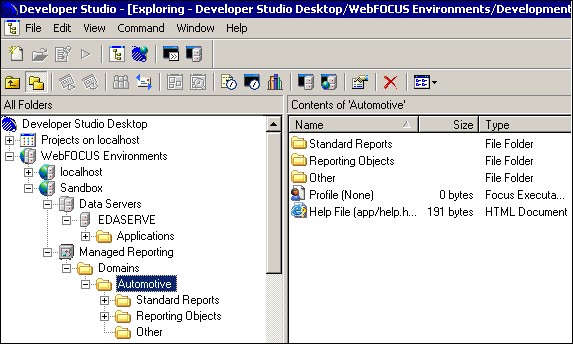
WebFOCUS Online Help > Managed Reporting Developer > Working With Domains and Standard Reports > Using Domains in Managed Reporting
How to: |
A domain organizes Standard Reports and Reporting Objects into logical groups, such as Payroll and Sales. A domain is organized into a series of folders and components. A domain contains the following elements:
|
Element |
Description |
|---|---|
|
Standard Reports folder |
Contains the Standard Reports you create for end users. Users run these reports, but they cannot change them. For information about creating Standard Reports for users, see Working With Standard Reports. |
|
Reporting Objects folder |
Contains views of your organization's data that users can access for ad hoc reporting and to create their own reports. |
|
Other Files folder |
Contains images (.gif, .jpg), StyleSheets (.sty), Cascading Style Sheets (.css), JavaScript (.js), HTML files and other files that you use to customize and enhance reports. Users cannot access this folder. The folder also provides temporary storage for reports and procedures that you are migrating from other WebFOCUS platforms. |
|
Profile component |
The domain profile runs each time a user opens the domain. This profile can display an HTML page or the results of a WebFOCUS procedure prior to entering a domain. For information about using profiles and help files, see Customizing Managed Reporting. |
|
Help component |
The help component contains an organization-specific help file that users can access from the Domains view reporting environment. For information about using profiles and help files, see Importing Procedures and Other Files Into WebFOCUS. |
WebFOCUS creates these folders whenever an Administrator creates a new domain. In Developer Studio, WebFOCUS organizes these folders and components for each domain in the Explorer.
The following image shows the Developer Studio application which is divided into two panes, the left pane displays all the folders in a hierarchical structure with the Automotive domain folder expanded and the right pane displays the Standard Reports, Reporting Objects, and Other subfolders for the Automotive domain.
In the browser, these folders appear below each domain in Domain Builder.
The following image shows a browser window containing the Domain Builder. In a hierarchical structure, the Repository is the root directory followed by Data Servers, two expanded domains (each has its own Standard Reports, Reporting Objects, and Other Files subfolders, Profile, and Help files), and User Management.
The following image shows the Acme Manufacturing Properties dialog box. Two check boxes with adjacent list boxes enable changes for the Server and Application Path, respectively.
Note: Domain properties can be set or reset at any time. Care must be taken that any change you make does not adversely affect the behavior of existing reports. For example, if you change the server or application path settings in the domain properties, all reports and reporting objects in that domain inherit these changes when you click OK.
Developers with the Data Server privilege can also use the MR Administration interface to set a domain's Server and Application Path properties. For more information, see the WebFOCUS Managed Reporting Administrator's Manual.
| WebFOCUS |